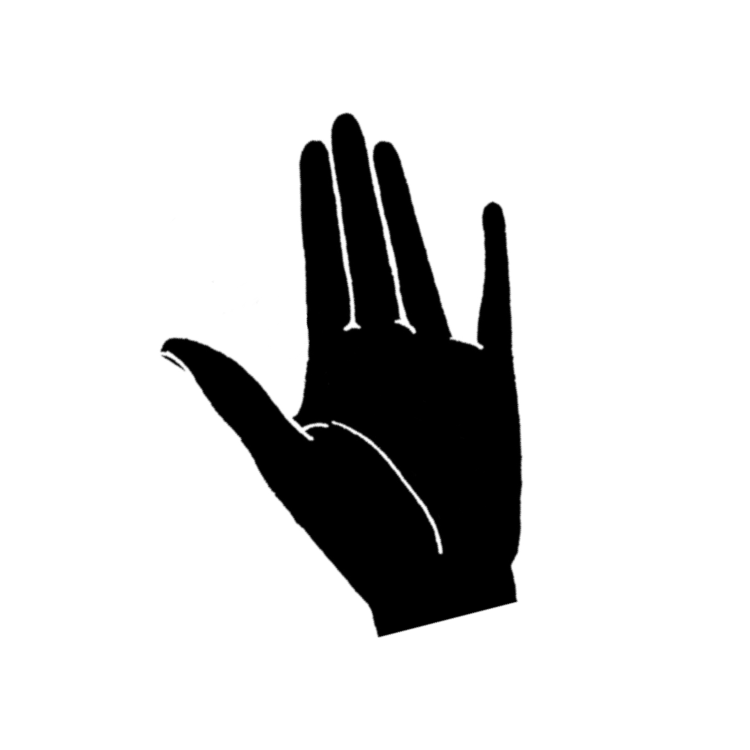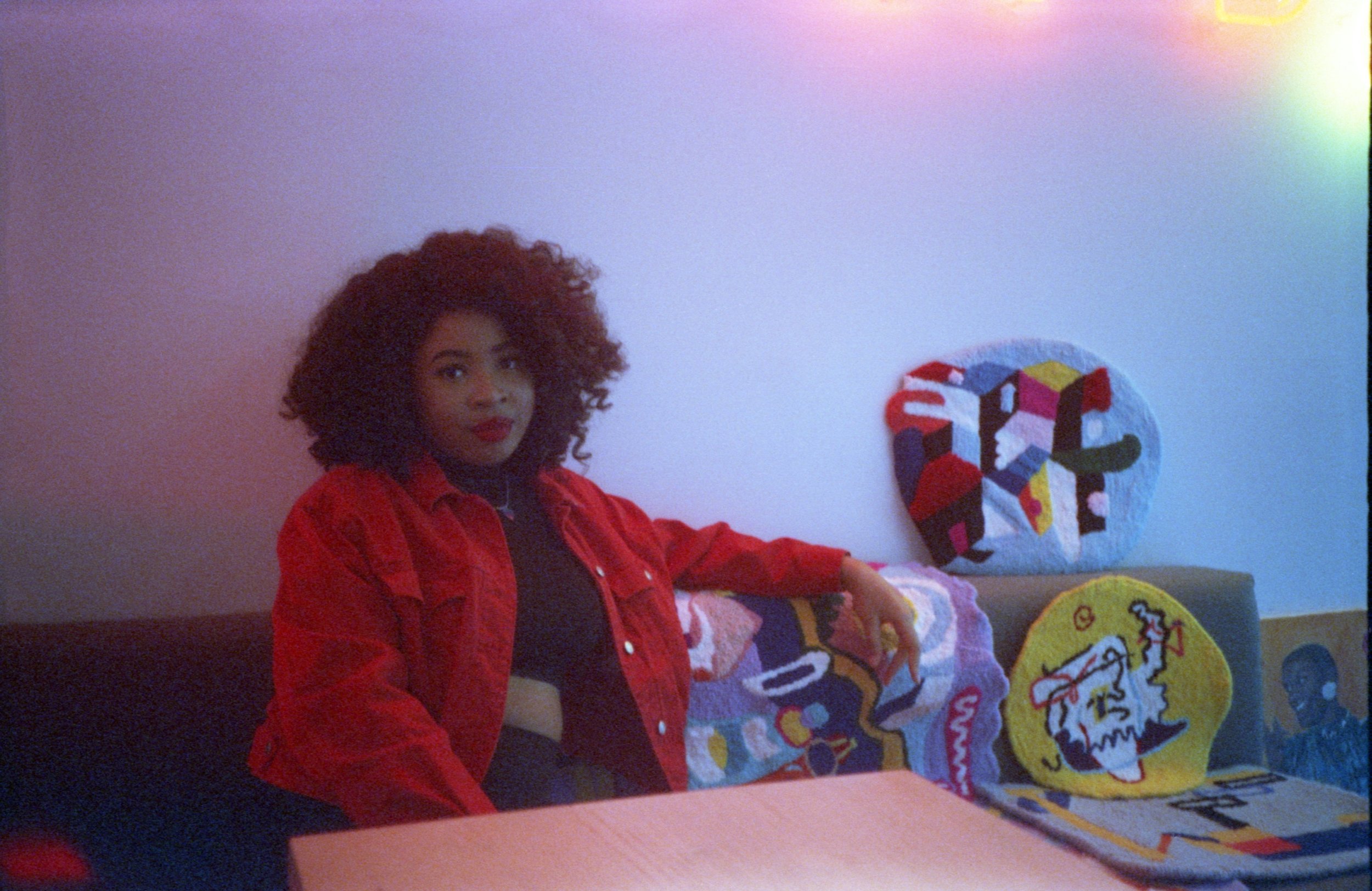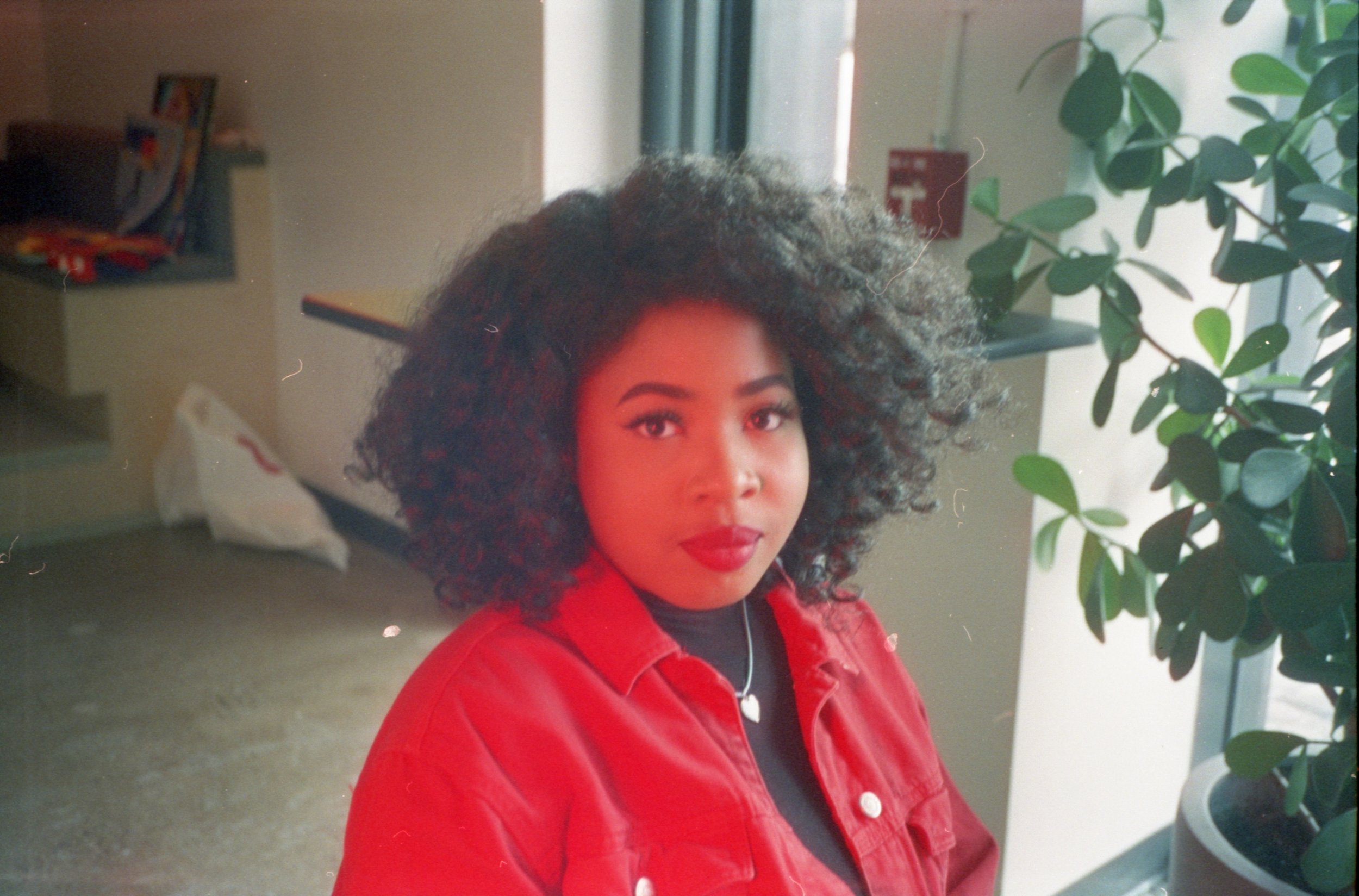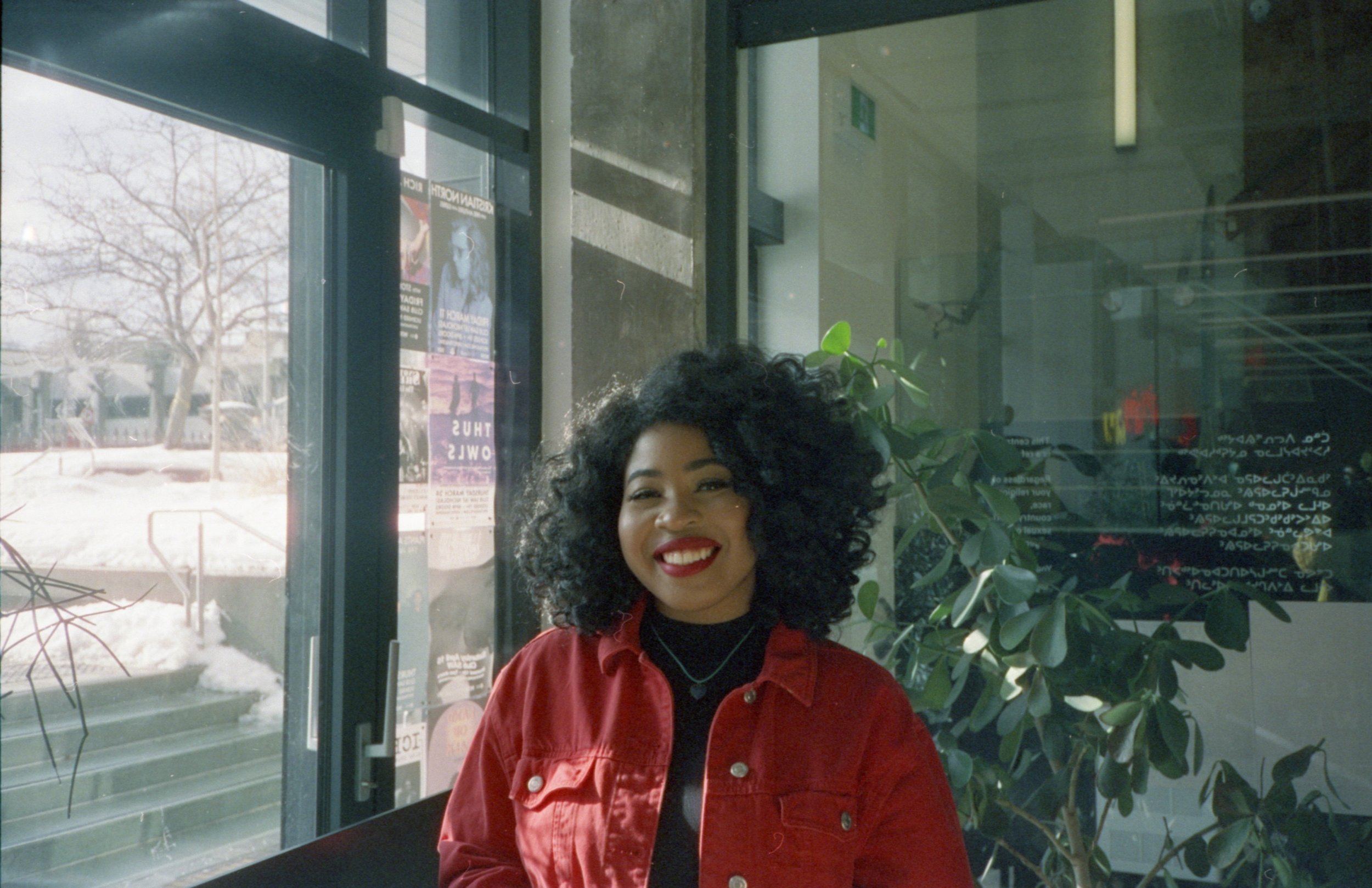Leading up to Pique on March 19th, 2022, we asked writer and photographer Nneka Nnagbo to choose an artist participating in Pique to feature.
Nneka chose Nigeria-born Ottawa-based painter and fibre artist Mesoma Onyeagba to focus on, and what follows – a short experimental film (featuring music by past Pique performer Jules Filmhouse inspired by Mesoma’s work), an interview, and a photo story – is Nneka’s profile of the artist.
Mesoma Onyeagba’s work will be exhibited as part of Pique spring edition on March 19, 2022 at the Arts Court (Atelier). Tickets are pay-what-you-can.
Meeting Mesoma
A short transmission about authenticity in art, depth and happiness, stepping out of the square, working with one’s hands, abstractions, and creating other worlds.
Words by Nneka Nnagbo & Mesoma Onyeagba
Photos and Video by Nneka Nnagbo. Video music by Jules Filmhouse.
Nneka: Who are you and tell us your name.
Mesoma: My name is Mesoma Onyeagba, born and raised in Nigeria. I'm the only girl out of three children. I'm the first born and I've always loved creating things. It has been part of me ever since I was a child—I wanted to be an artist.
I wanted to be an artist ever since I touched paper. I started drawing girls mostly. And when I went to high school, that was what I said to myself; I wanted to be an artist. But people, especially my teachers, were like, “Oh, don't do that. You won't be successful. You wouldn't make money. You wouldn’t do anything great with it.” You know? It just really hit me. I thought, “Okay, they must be right.”
Because I didn't know what was right and what was wrong; I was just following my elders [because] I respect them. [I respect] people, my teachers, and everything. So, I went into architecture. Because that was close to art [and] I wanted to do something with art.
Then I took a class called Technical Drawing in preparation for my architecture program, and was really good at it. I loved it.
You need specific rules for [technical drawing]. Like how to construct. But me, I use my head to construct [the drawing]. I got the best in technical drawing. I use my intuition to do it. I don't like to follow the rules.
The only problem I had with studying architecture was with “the maths.” I don't like math. I cry.
By the end of my my high school year, I went to Toronto for a preparatory program to get used to Canada. I still took the course in architecture, and it was still hard.
I'm someone that easily follows society, and follows their standards. And that's part of the Nigerian culture. It’s like, “you have to do this and this, you have to be a doctor, you have to be this.” And the best part is my parents; they were never judging me. They told me to do anything I wanted to do, but it's me and the society and my environment that influenced me to go for other things. When I went to Toronto, I just cried. I'm like,“I'm not truly happy with this.” I called my dad: “I don't want to do this. This is not what I want to do. I want to change.”
And, initially, I wanted to study fashion design. But I didn't know how to sew—you have to be good at sewing. You have to do other things. You have to have a portfolio for it, and I didn't know how to make a dress.
So [I said], “okay, I guess that won't work out because they need specific requirements, and I don't have any of that.” But I knew I used to sketch dresses—like drawing dresses in Nigeria. So I went into visual arts. It's not overly about self-expression. It’s because I know I want to use my hands to make something that's not of this world. Like, creating something of my own. That's why I'm like, “I can do anything that requires art. As long as it has art in it, I'm okay.” So I studied Visual Arts at UOttawa (Ottawa University). It was really a cool experience.
When I got to UOttawa, I noticed that everyone [was] intellectual. They were expressing their feelings. They were really smart and they were explaining some things about society. And [I thought], “am I in the right place?” Because me, I like pretty stuff.
I like to make things beautiful. I like to create something that you can smile to. [Something] you can put in your house. I want a piece of me to spread everywhere. But I'm trying to learn how to be self-expressive [through my art]. I'm more self-expressive face-to-face; talking to people. But I don't express myself too much in my art. I want to portray beauty. I want to create something that's out of this world.
That definitely comes across too. Whenever I've looked at your work, it feels very happy and rich. That's why that one is one of my favourites; because you can really feel the expression on their face. I find it's like that a lot with some of your other pieces too. I think that's the common theme. It's very bold and very warm as well. It's really nice.
Yeah. That's it. That's exactly what I want to portray. When I went [to UOttawa] I just felt a bit alien. Like, “am I actually doing the right thing?” Because I was still trying to listen to the society. It's [only] recently that I started to say, “no, I'm just going to do what I want.”
I'm the one that learned how to do punch needling. They don't study that in my school. I’m the first person to do that. And I'm focusing on painting [in school]. So, this is me painting with fibre. I use fibre to paint abstraction like how I use paint.
[An aside: Yarn is made from fibres. Punch needle embroidery is a kind of fibre art].
I don't want to just stick to painting. I want to go explore. I want to go crazy. I want to find myself through different mediums of creating. And I just have to accept that for me. I can’t just lie to myself anymore that I need to create something really rich and talk about deep stuff—and it's not a bad thing; I'm just not good at it. But I'm learning to be good at it. Because it's kind of useful too.
I represent Black women because that's me. That’s my Nigerian roots. Abstraction is for my own imagination, my fantasy. I’m trying to see what I can do. It's like a mental exercise. Like, “let's think outside of the box.” And this is just the beginning. I want to step out of the square. I want to create my own world. I want you guys to know what I can do.
I have this thing about names and etymology. [An aside: Etymology is the hi(story) of words and their origins. And a name is like the etymology of a human being’s physical existence; it’s our personal, unique, individual hi(story). Our names originate us from somewhere. Whenever we meet someone new, it’s like we’re telling them a story about ourselves through our name]. So, I like to ask people sometimes if they know what their names mean. What does your name mean?
My full name is actually Mesomachukwu. Mesoma means goodness. So, Mesomachukwu means Goodness of God.:
I feel I have goodness in me. I feel I relate to that; the meaning of my name. I'm very, very honest. I don't know how to lie. What I'm depicting is me. Maybe, I do not know how to express myself yet, but I know that this is me. And whenever I touch paint, people tell me, “Oh, this is Mesoma that made this.” And I'm like, “Really? I didn't know that you noticed.” I didn't know I have a style, but I'm getting to accept that I have a style, I guess. So. Yeah. Goodness—I believe that's me.
I think that's why I had such a visceral response to your work when I first saw it. Especially your style of stitching—punch needling. When I saw that, I was like, “What are those? Those are so cool.” I was really interested in it.
When I look at something, I already plan my future with it. So I'm like, “Okay, this is actually going to help me create things that I want to create,” because I'm also into fashion design. And this [punch needling] is kind of related to [that], but not yet. It's still loading. It's just the beginning.
If I see your sweater, I'm like, “okay, I can imagine something with it.” I could imagine a room with it. I could paint something with the expression of your shapes. When people ask me where my inspiration comes from I’m like, “it's anything.” It's really anything. Even when I watch YouTube videos and I see people create, it gives me the inspiration, the motivation to actually make something. When I make something, I get the paint and just start putting [things down]. I don't think too much. I prefer abstract because it just lets me do what I want. That's why my inspiration is everywhere. I have so many ideas but I can’t make everything. I wish I could, but I can't. Even the door—I can do something with that. I have a vision in my head that I could create. I could just multiply the shapes.
You're a very visual thinker.
I’m very visual. People look at me sometimes [and] I look confused because I'm thinking of something else. I don't notice people sometimes. I look at you, but I'm not looking at you. I'm thinking of something—thinking of an idea. I get lost a lot in my fantasy world.
I'm always curious about how people define art. So I would love to hear how you define it. What does art mean to you? Like, the concept of art and also the act of making art?
I guess art is, for me, just creating something that's unique and, I guess, brand new to the world. But it's hard to create something brand new. Sometimes I search online [and] I'm like, oh, this reminds me of my work.” We're all connected in some way. To be honest, art is kind of meditation for me. I'm more into the process. I like the process; the painting. Usually, even when I paint, I watch Netflix on my phone and just laugh. It's just normal for me. It helps me stay in the moment. It helps me distract myself from overthinking about the future or the past. It's kind of like a mental exercise for me.
I use [art] to challenge myself out of the normal. I’m trying to not be normal.
I'm curious about the specific fabric and material you use, and what drew you to this style? How did you wind up in this creative space?
It's yarn and it's wool. I would try to use other materials one day, but for now, this is good. I want to get into embroidery, in general. The reason why I went for this is because of the yarn. When you go to the store, you see bright colours, like straight-out-of-the-tube colours, and I'm inspired by primary colours cause they're just very vibrant and saturated. I don't like dim colours too much. Yarns have different colours— like pink. You can notice for my paintings, they're usually vibrant. Yarn is something that's vibrant. You can easily mix different colours and it's just free.
It's very elastic and fluid too. So it's probably really flexible to work with.
Yeah, and it’s really soft. You can hold it and squeeze it. I also use felt behind [it]. Cause I like that idea of softness. It's precious. Usually on TikTok they use it for the floor. They call them rugs. People also called mine rugs, but I'm like, “that's not the idea.” This one is for the wall or your bed. I want it to be precious. Cause I use my hands to make it. It's not like a machine. I use my hands to make everything.
How long does that take?
Four hours a day. It took six days for this one.
And how did you arrive at the punch needling style that you have now?
I don't usually think too much, but I also use Procreate to help me design the shapes. But I get my inspiration from my older abstract paintings—I look at them and can get some colours from them. Then I transfer it to Procreate and draw my own. I like to be mostly self-inspired because I value authenticity very much. I try to get my own inspiration for myself. So, sometimes if you see my other paintings, when you look at one, you can see the connection to the other one. I'm trying to get inspired by myself, if that's possible.
I am also really interested in the process of making art. Cause, I see the finished product and I'm like, “wow, this is beautiful,” and I'm always so curious about how people make things. What I like about these pieces too is they are very 3D. Like it's kind of moving off of the felt. You feel like you can literally reach over and touch it.
It’s like flat sculptures.
So, I already told you about my favourite pieces, but I wanted to ask you what your favourite piece is.
I like this one.
[An aside: Mesoma holds up the purple piece titled Punch Purple]
I love the colours. I love the purple. I used to try and wear it. It's giving me possibilities that I can actually make a dress. This was the inspiration for it. I like big stuff.
This on its own [took] a long time to do—a whip stitch is what it’s called.
[An aside: Mesoma uses a whip stitch technique for the edges of her fibre art]
I know how to sew, but I don't know how to use a machine. I tried to. I ordered the gun; it's called a tufting gun. It was quite scary, so I never touched it again. I feel it's much more intimate to do it by hand, and it keeps me busy. The tufting gun’s really fast and I don't like fast work. I like when I'm taking my time.
What inspires you to create? Colours, sound, textures, images, anything.
I used to watch a lot of Disney princess movies—they were so bright. And also my Nigerian culture—that one is more subconscious. I was surrounded by all these patterns, but it was normal to me because I was living there. But when I came here, I said, “Wow, Nigeria has a lot to offer.” I used that to my advantage, and the way they use straight, vibrant, bold primary colours, mostly. But I try not to think too much, because I’m trying to make it my own.
Is there anything that you are trying to convey through your art?
The use of colours is something that draws people’s attention. So, it's like my art is saying, “notice me.” I'm just trying to be honest. That's the truth. It just grabs people's attention to get to know me more through my art.
That, and intensity and the confident use of colours. I want to portray intensity and confidence. I appreciate beauty for the abstraction. But for painting, it's like representation of people that look like me more. The paintings are more important. I want to play a role in the society. I want my paintings to represent something. When it's in the gallery, I want you to be able learn something about it. I want to paint different tribes of Nigeria one day.
So this is just the beginning. Everything is just the beginning.
How do you connect with the world through your art?
For [my] paintings of Black women, I know this is about me, but I think of people too. Let them see a black woman. I want them to be able to look at themselves, as a Black woman, like, “Oh, that's me—that looks like me—this reminds me of my sister—Oh, I have this fabric—I know this Nigerian textile.” I try to paint things that are familiar. I'm trying to make it educative. I'm trying to also be serious and be less serious.
My fibre artworks are more for inside your house. These pieces are “me”. So it’s like having a piece of me in your house.
These pieces are kind of like a look inside your world. Each piece represents something different, but there's that continuous thread that flows through all of them. And with the painting, it feels like you are communicating a very honest feeling.
You know when you see a painting that is really smooth? I like to show the detail. Like I said, I like rawness and authenticity. I want to see the pimple. I want it to be as real as possible. This [painting] is the less realistic painting of mine—I'm also into portraying people the way they are. You know when you see some artists and they have one shade of black for them? That’s not me. I like to separate the colours, and get millions of colours for that person.
Yes, people are complex. The details are important.
If your art could speak, what would it say?
You can kind of see harmony and connection [in my art]. Everything's connected. I want to depict visual harmony between the viewer and my work. Togetherness. I feel they are different worlds. That's why the name [of this body of work] is a Vivid Coalition. It's like different people and patterns, but connected and united. That’s why I paint people together. I don't just paint one person. I like intimacy—harmony and intimacy.
And if your art had a feeling, how would it feel?
Happy.







